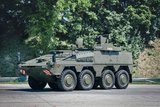Resilience, adaptiveness and collaboration vital for success in space (Studio)
Brought to you in partnership with Amazon Project Kuiper Government Solutions
Representing government, academia and the private sector, discussion on the first morning of DISC 2025 focused on the need for a resilient, adaptive and collaborative approach to space as a new battleground and to facilitate real-time communication.
As the nature of warfare changes, speakers emphasised the need to take a strategic approach, such as looking to hybrid solutions, in anincreasingly congested and contested domain.
Impact of the UK Strategic Defence Review
In his opening address, Cdre Tony Williams, Head of Space Capability, UK Space Command, said that the country's 2025 Strategic Defence Review (SDR) elevates space to parity with land, sea, air, and cyber, recognising it as a critical national infrastructure element and vital for operational advantage.
The SDR foregrounds a strategic aiming point over rigid plans, addressing threats such as anti-satellite weapons, cyber attacks and space debris.
Williams said the UK’s approach is guided by a flexible “own, collaborate, access” framework that balances sovereignty and the ability to act independently, while sharing innovations. He stressed the importance of partnerships with NATO, the Five Eyes community, and the Combined Space Operations Initiative, all of which he said were essential for collective deterrence and ensuring freedom of action in space.
The UK Defence Industrial Strategy meanwhile aims to maximise resources, share expertise and remain at the forefront of innovation, Williams told the conference. To achieve a culture of innovation, risk-taking and integration, he said the SDR focuses on workforce skills, while working closely with engineering partners, academic researchers, civil agencies and the private sector.
“This is why the SDR’s emphasis on workforce skills and mindset is not a soft issue,” Williams added. “It is quite literally a matter of strategic success or failure, and this is where today's audience comes in because the UK space enterprise is broader than defence.”
The UK aims to create a hybrid solution that takes account of owned capabilities, commercial provision and collaboration, balancing orbital regimes and opportunities, Williams said. He pointed out that the reliance on space-based services creates a paradox of rising demand and intensifying threats. In this regard, the SDR is clear: “It's not about having the most exquisite satellites, it's about having a resilient and adaptive posture that fits with operational needs.”
Williams concluded: “The SDR sets our ambition, but we will not reach it unless we move together deliberately and faster. We are in a moment where space is not just shaping the fight, it may well be where the next fight begins.”
Integrating government and commercial strengths
In his keynote address, Michael Moran, Director of US Government Business at Amazon Project Kuiper Government Solutions, added his voice to the support of hybrid solutions for space-based technology projects.
“The key is building hybrid architectures that are interoperable, secure, and mission-adapted,” he said. “It’s not about choosing between government or commercial, it’s about integrating both.”
With a growing worldwide recognition of the importance of space-based solutions to national security, Moran said the hybrid approach makes the most of experience and innovation across public and private sectors, requiring “seamless integration across all domains and organisations.”
“I want to emphasise that future warfare will be shaped by how effectively we integrate space capabilities and more broader military architectures,” Moran told the conference. “Those who master this integration, who can leverage space-based communications to seamlessly connect warriors in all domains, who can move data securely across these domains at the speed of relevance, will have the decisive information advantage.”
For Amazon Project Kuiper Government Solutions, Moran said space-based capabilities, such as low-Earth-orbit constellations, are transforming the architecture of warfare and this is best achieved with constructive government and commercial innovations: “This is critical to maintaining our edge in an increasingly contested domain – space is no longer just the high ground, it's the essential connected layer that enables everything from precision strikes to humanitarian aid.”
Industry partnerships and investment
In a fireside chat, David Black, Head of Satellite Coordination at UK Space Command, talked with Dave Broadbent, President and CEO, SES Space and Defense, about the shift from just satellite communications to commercial investment in other capabilities, such as missile warning and tracking or space situational awareness.
Black cited the US Space Development Agency as an example of overcoming “ossified” bureaucracy for “remarkable” outcomes: “They got rid of the bureaucracy and they scored four small, empowered teams that were based principally around output-based objectives, where those teams were incentivised and given a lot more flexibility in terms of how to achieve their outcomes”, such as 22 satellites operating within less than three years.
“They've completely changed the game in terms of how they're going to acquire these space-based intercepts,” said Black. “Effectively, what they're saying is, ‘Look, industry, we don't care whether you’re big aerospace defence companies like Boeing, or whether you're one of the new space start-ups, we want you to focus on your own prototypes.’”
Looking at the broader impact of space technology investment, Broadbent pointed out that there is a large customer base, which he said lowers the risk for industries interested in this field: “If the government doesn’t buy it, someone else will.”
Black said there had been a shift from sole-source cost-plus contracts to a more competitive market with new space start-ups. Furthermore, he explained that the acceptance of hybrid architectures has increased appetite for investment, especially in the US, where government is “far more comfortable with using commercial dual-use technologies to address certain space missions.”
“Government obviously has to set the vision, and it has to establish the training environment and the priorities,” said Black. “But it absolutely must be a partnership with industry.”
Instead of traditional procurement, where industry “is waiting for an exclusive set of requirements”, Black said a better example comes from the Space Warfighting Analysis Center in the US, which “looks at what the Space Force design should be and it really drives what the requirements need to be in a timeframe of two years, five years, ten years”, so unified, flexible architectures can be created to cope with evolving threats.
Proactive in an uncertain world
Lastly, an industry panel on geopolitics and the space domain discussed NATO’s evolving strategy, again emphasising the importance of commercial capabilities. The conversation also covered the challenges of managing space threats and the need for proactive measures to enhance resilience, deterrence and security.
Daniel Hilgert, Senior Space Coordinator at the alliance, said governments need to “become more intelligent customers in defence.” Among NATO members, there is an increasing reliance on commercial services, which he described as “awesome”, but cautioned that this can create vulnerabilities, especially with satellite communications and space-based intelligence, surveillance and reconnaissance.
“We’ve seen a lot of nations are very heavily relying on single providers, although the commercial market is so diverse and so vibrant,” Hilgert said. “We're going to work on developing a marketplace for space services – that's also super-important when we talk about diversifying our sources to become more resilient.”
Professor Trevor Taylor, Director of the Defence, Industries and Societies Programme at the Royal United Services Institute, raised the geopolitical challenges posed by China’s successful docking of satellites in geostationary orbit, expressing concern about “the ambiguity in intentions.”
However, he suggested opening a constructive dialogue with Beijing to explore how the country benefits from space, while reducing reliance on Chinese-made components and equipment because of political concerns.
Taylor added that China may be more open to this dialogue than Russia because it is “so heavily knitted into the global economy and the popularity and survival of the regime in China is so heavily tied up with building prosperity.”
Security in space
Dr Antje Notzold, Research Associate and Lecturer, Technical University of Chemnitz, focused on Germany’s multi-billion dollar investment in its National Space Management programme, which she described as “a very strong signal.”
“Even though we are still lacking our first space security strategy – it was announced in 2023, it’s still not published yet, but as far as I know from the defence ministry, it is going to come this year – it should send signals that Germany is going to improve its resilience and deterrence in space,” she said.
Notzold added that Germany is planning investment in technologies such as new geostationary communications satellites and a missile detection sensor network, to enhance space domain awareness and build capacity to act defensively and offensively.
While she said operating in the domain is “something very new” for Germany, the investment plans represent “a change in attitude to what space means for the German Armed Forces, for German security and defence policy, [as well as bringing] new capabilities to the table for raising Europe's autonomy and for being able to act in space.”
Dr Ivan Janes, Chief Systems and Programmes Analyst, Stellar Solutions, stressed the critical role of cyber security in space services and how that should be a priority for procurement across “all links of the supply chain.”
“The visibility of risk is, in certain areas, not high enough, so we have technologies to bridge that gap, like digital twins, where we can actually simulate the whole system and do exercises to showcase the risks and availability of the systems,” he said.
“We need a bit more incentive to actually include security-by-design elements into the procurement processes to mandate that security is really taken from the ground up.”
“To manage IT and cyber risks that come from the classified domain, there could be operational technology risks that are more specific to missions,” he continued, adding that there has been “very good advancement” in cyber security awareness. “Cyber security at the end of the day is not an optional cost that we have, but it is actually an essential enabler.”
- Project Kuiper has now been rebranded as Amazon Leo. To find out more about space-as-a-service by Amazon LEO, click here
More from Studio
-
![Light Reconnaissance Strike – enabling a vital mission set (Studio)]()
Light Reconnaissance Strike – enabling a vital mission set (Studio)
A new system-of-systems concept will unlock digital integration of sensors and weapons for Light Forces, allowing them to shape the battlefield environment on their own terms and upgrade legacy platforms.
-
![Energy evolution: How laser defence systems are powering the next phase of air defence (podcast)]()
Energy evolution: How laser defence systems are powering the next phase of air defence (podcast)
Laser-based air defence is moving from promise to deployment as global threats evolve. In this special podcast, we explore how high-energy laser systems are reshaping interception strategies.
-
![Unlocking the potential of Light Forces in modern warfare (Studio)]()
Unlocking the potential of Light Forces in modern warfare (Studio)
The Ukraine conflict has highlighted the strategic importance of “Light Forces” – rapidly deployable dispersed units, able to conduct an expanding range of mission sets. What technologies and equipment are needed to ensure their success in combat?
-
![Precision on Demand: The New Age of Loitering Weapons (Podcast)]()
Precision on Demand: The New Age of Loitering Weapons (Podcast)
Loitering munitions provide vital capabilities in the disrupted and unpredictable modern battlespace, from real-time ISR to a virtually “on demand” strike capability. Rafael is looking to the future of the technology, empowering systems to operate with increasing autonomy in hostile environments.
-
![Beyond Survivability: How Active Protection Systems Are Empowering Commanders (Podcast)]()
Beyond Survivability: How Active Protection Systems Are Empowering Commanders (Podcast)
As threats diversify and intensify, APS are proving essential not just for vehicle protection but also for enhancing operational freedom, effectiveness and mission success in contested environments.
-
![Combat-proven capabilities: How precision-strike systems are evolving for tomorrow’s battlespace (podcast)]()
Combat-proven capabilities: How precision-strike systems are evolving for tomorrow’s battlespace (podcast)
Combat-tested technology is being reshaped to counter A2/AD threats, reduce reliance on GPS and enable faster, more autonomous targeting in complex environments. In this special podcast, experts explain how the evolving threat landscape is shaping next-generation strike capabilities.


























